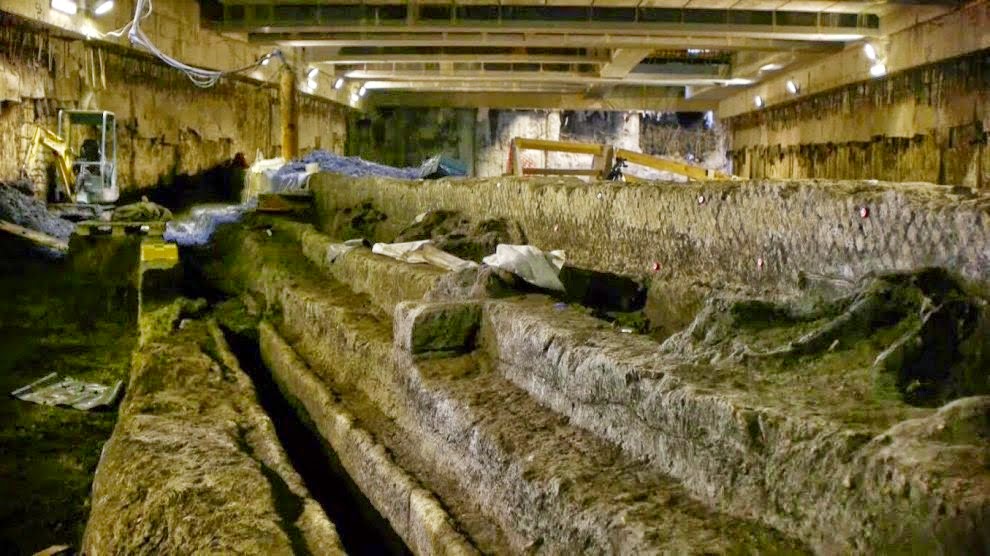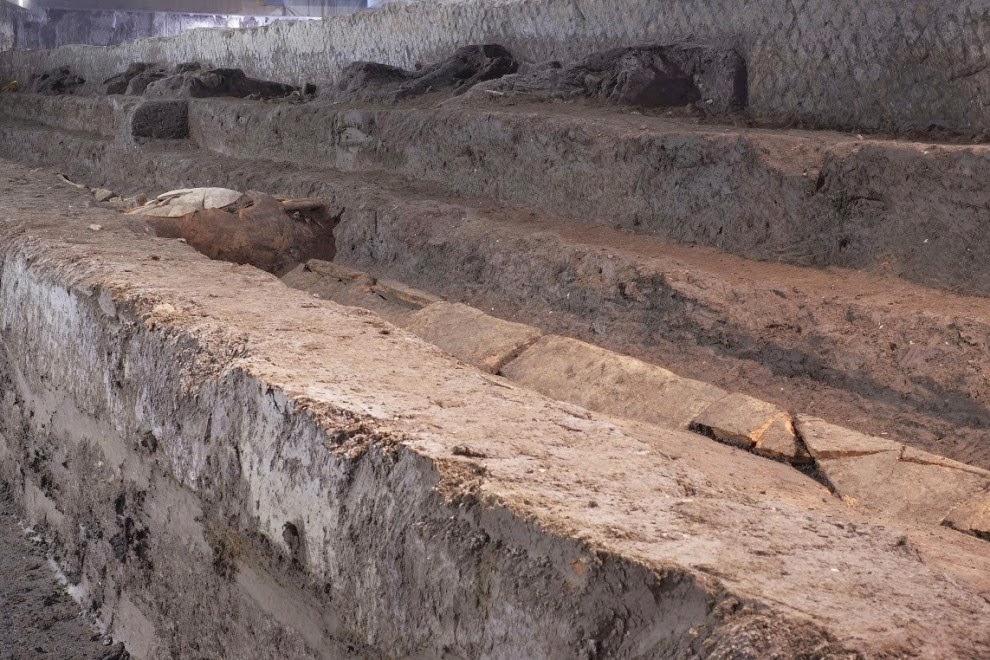Buone notizie, ma anche cattive notizie.
- Cominciamo dalle cattive: i ritardi per la realizzazione della Metro C romana si allungano, e parecchio.
- Le buone: ad una profondità di 20 metri circa - nel corso di detti scavi, presso la Basilica di San Giovanni in Laterano - è stato rinvenuto il bacino d'irrigazione (superiore ai 35 mt per 70 mt, per una capienza calcolata di circa 4 milioni di litri) di una grande fattoria del I secolo a.C. (la più vicina a Roma mai rinvenuta), che si riforniva dalla vicina sorgente dell'Aqua Crabra, che allora formava un fiumiciattolo nella zona. Restò in 'servizio' per circa un secolo, poi fu interrata.
Numerosi i reperti: forconi a tre rebbi, cesti di vario genere, resti di pellami (forse guanti o calzature, usate se non addirittura prodotte in loco), tracce lasciate sulla pietra dalla rotazione continua di pale di mulino. Interessante la malta idraulica ed il cocciopesto usato per rivestimento. Numerose le opere in laterizio ed in argilla. Presenti alcune decorazioni in 'opus reticulatum'.
Sono anche stati rinvenuti i resti di radici di salice e numerosi ceppi di altre piante. Semi di pesca, che costituivano ancora oggetti di lusso (erano ancora una rarità di provenienza medio-orientale), sono stati rinvenuti numerosi quasi ovunque, intorno, tanto da far pensare che l'azienda agricola fosse monocolturale. Il reperimento di un sigillo frequente, con le lettere TL, lascia credere che il proprietario avesse queste iniziali.
Che già gli antichi romani riciclassero è dimostrato dal reperto dell'allineamento di anfore con fondo tagliato, allineate a formare condutture idriche.
Rossella Rea, direttrice degli scavi, ha dichiarato che questi saranno resi visibili dai fruitori della Metro C , nella stazione di San Giovanni e che gli oggetti asportabili relativi allo scavo saranno messi in mostra nei musei romani.
Metro dig uncovers
largest reservoir of Imperial Rome
- Cominciamo dalle cattive: i ritardi per la realizzazione della Metro C romana si allungano, e parecchio.
- Le buone: ad una profondità di 20 metri circa - nel corso di detti scavi, presso la Basilica di San Giovanni in Laterano - è stato rinvenuto il bacino d'irrigazione (superiore ai 35 mt per 70 mt, per una capienza calcolata di circa 4 milioni di litri) di una grande fattoria del I secolo a.C. (la più vicina a Roma mai rinvenuta), che si riforniva dalla vicina sorgente dell'Aqua Crabra, che allora formava un fiumiciattolo nella zona. Restò in 'servizio' per circa un secolo, poi fu interrata.
Numerosi i reperti: forconi a tre rebbi, cesti di vario genere, resti di pellami (forse guanti o calzature, usate se non addirittura prodotte in loco), tracce lasciate sulla pietra dalla rotazione continua di pale di mulino. Interessante la malta idraulica ed il cocciopesto usato per rivestimento. Numerose le opere in laterizio ed in argilla. Presenti alcune decorazioni in 'opus reticulatum'.
Sono anche stati rinvenuti i resti di radici di salice e numerosi ceppi di altre piante. Semi di pesca, che costituivano ancora oggetti di lusso (erano ancora una rarità di provenienza medio-orientale), sono stati rinvenuti numerosi quasi ovunque, intorno, tanto da far pensare che l'azienda agricola fosse monocolturale. Il reperimento di un sigillo frequente, con le lettere TL, lascia credere che il proprietario avesse queste iniziali.
Che già gli antichi romani riciclassero è dimostrato dal reperto dell'allineamento di anfore con fondo tagliato, allineate a formare condutture idriche.
Rossella Rea, direttrice degli scavi, ha dichiarato che questi saranno resi visibili dai fruitori della Metro C , nella stazione di San Giovanni e che gli oggetti asportabili relativi allo scavo saranno messi in mostra nei musei romani.
Metro dig uncovers
largest reservoir of Imperial Rome
Archaeologists have
unearthed an ancient commercial farm in the heart of modern Rome, taking
advantage of subway construction to explore deeply in urban settings.
View of the metro C dig
at San Giovanni, Rome
[Credit: La Repubblica]
They worked some 20
meters down (some six stories deep) near St. John in Lateran Basilica.
Today's Rome rests upon medieval layers and, under those, more ancient strata of life. Rossella Rea, the dig's leader and a culture ministry official, said Wednesday that archaeologists discovered a first-century agricultural business, the closest to Rome's ancient center ever found, an irrigation basin measuring 35 by 70 meters (115 feet by 230 feet), and an extensive drainage system near the ancient Aqua Crabra water source.
Today's Rome rests upon medieval layers and, under those, more ancient strata of life. Rossella Rea, the dig's leader and a culture ministry official, said Wednesday that archaeologists discovered a first-century agricultural business, the closest to Rome's ancient center ever found, an irrigation basin measuring 35 by 70 meters (115 feet by 230 feet), and an extensive drainage system near the ancient Aqua Crabra water source.
Archaeologists have unearthed an ancient
commercial farm in the heart of modern Rome, taking advantage of subway
construction to explore unusually deep for urban settings. They explored
some 20 meters down (around six stories deep) near St. John in Lateran
Basilica. Rossella Rea, the dig's
leader and a culture ministry official, said Wednesday, Dec. 3, 2014 a
farm business from Imperial era Rome was discovered, along with an
irrigation basin measuring 35 by 70 meters (115 feet by 230 feet) near an
ancient water source known as Aqua Crabra
[Credit: Cooperativa
Archeologia]
Notable finds included a
three-pronged iron pitchfork, storage baskets, leather fragments possibly from
a farmhand's glove or shoe, and traces carved into stone by a waterwheel's
repeated turning.
Also extraordinary are well-preserved vestiges of willow and other tree roots and stumps. Peach pits, presumably from the farm's orchard, also were found.
Peaches were still a novelty, first imported from the Middle East.
'They were almost luxury items," Rea told The Associated Press at the American Academy in Rome, where a conference discussed the findings.
Ancient Romans recycled.
Amphorae, the jars they favored to transport and store food, were lined up with their ends cut open to double as water conduits.
Other older signs of life were carriage ruts from as long ago as the 6th century B.C. Rea said some discoveries will eventually be integrated into the St. John's subway station so the public can see then, while other artifacts will go on display in Rome museums.
Visitors will have a long wait for that subway station. Metro C line construction is running years behind schedule.
Also extraordinary are well-preserved vestiges of willow and other tree roots and stumps. Peach pits, presumably from the farm's orchard, also were found.
Peaches were still a novelty, first imported from the Middle East.
'They were almost luxury items," Rea told The Associated Press at the American Academy in Rome, where a conference discussed the findings.
Ancient Romans recycled.
Amphorae, the jars they favored to transport and store food, were lined up with their ends cut open to double as water conduits.
Other older signs of life were carriage ruts from as long ago as the 6th century B.C. Rea said some discoveries will eventually be integrated into the St. John's subway station so the public can see then, while other artifacts will go on display in Rome museums.
Visitors will have a long wait for that subway station. Metro C line construction is running years behind schedule.
Author: Frances D'emilio
| Source: The Associated Press [December 03, 2014]








